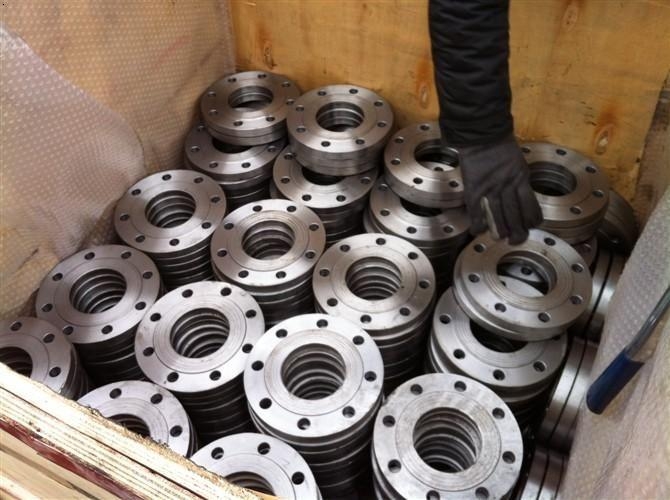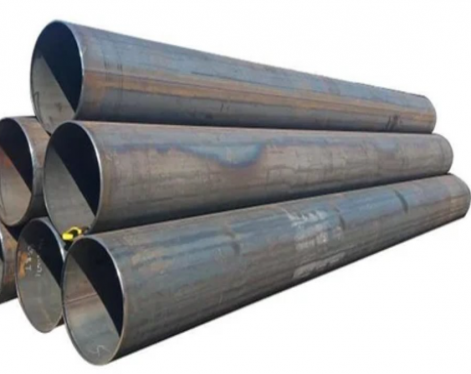The flange connection of the seamless pipe is to fix two pipes, pipe fittings or equipment on a flange respectively. Then add flange pads between the two flanges, and finally tighten the two flanges with bolts to make them tightly combined. A detachable joint. The connection between stationary pipelines and rotating or reciprocating equipment can be realized.
Connection method
Seamless pipe flange connection methods can generally be divided into five types: flat welding, butt welding, socket welding, loose sleeve, and thread. The first four are described in detail below:
1. Flat welding: Only the outer layer is welded, and the inner layer does not need to be welded; it is generally used in medium and low pressure pipelines, and the nominal pressure of the pipeline is lower than 0.25MPa. There are three types of sealing surfaces for flat welding flanges, namely smooth type, concave-convex type, and tongue-and-groove type. Among them, the smooth type is the most widely used, and it is affordable and cost-effective.
2. Butt welding: The inner and outer layers of the flange must be welded. It is generally used in medium and high pressure pipelines. The nominal pressure of the pipeline is between 0.25 and 2.5MPa. The sealing surface of the butt welding flange connection is concave and convex, and the installation is more complicated, so the labor cost, installation method and auxiliary material cost are relatively high.
3. Socket welding: generally used in pipes with nominal pressure less than or equal to 10.0MPa and nominal diameter less than or equal to 40mm.
4. Loose sleeve: generally used in pipelines where the pressure is not high but the medium is relatively corrosive, so this type of flange has strong corrosion resistance, and the material is mostly stainless steel.
This connection is mainly used for the connection of cast iron pipes, rubber-lined pipes, non-ferrous metal pipes and flange valves, etc. The connection between process equipment and flanges is also flanged.
Characteristics of seamless pipe flange connection
The main features of flange connection are easy disassembly, high strength and good sealing performance. When installing the flange, it is required that the two flanges should be kept parallel, and the sealing surface of the flange should not be scratched, and should be cleaned. Flange gaskets should be selected according to design regulations.

Seamless pipe flange connection process
1. The connection between the flange and the pipe must meet the following requirements:
(1) The center of the pipe and the flange should be on the same horizontal line.
(2) The center of the pipe and the sealing surface of the flange form a 90-degree vertical shape.
(3) The position of the flange bolts on the pipeline should be consistent.
2. Pad flange gasket, the requirements are as follows:
(1) In the same pipe, the gaskets selected for flanges with the same pressure should be the same, so that they can be exchanged with each other in the future.
(2) For pipes using rubber plates, it is best to choose rubber gaskets, such as water pipelines.
(3) The principle of gasket selection is: choose as close to the small width as possible, which is the principle that should be followed on the premise that the gasket will not be crushed.
3. Connection flange
(1) Check whether the specifications of flanges, bolts and gaskets meet the requirements.
(2) The sealing surface should be kept smooth and clean without burrs.
(3) The threads of the bolts should be complete without any defects, and the fit should be natural.
(4) The texture of the gasket should be flexible, not easy to age, and the surface should not be damaged, wrinkled, scratched and other defects.
(5) Before assembling the flange, the flange should be cleaned to remove oil, dust, rust and other sundries, and the sealing line should be removed.
4. Assembly flange
(1) The flange sealing surface is perpendicular to the center of the pipe.
(2) Bolts of the same specification have the same installation direction.
(3) The installation position of the flange installed on the branch pipe should be more than 100 mm from the outer wall of the standpipe, and the distance from the wall of the building should be 200 mm or more.
(4) Do not bury the flange directly in the ground, it is easy to be corroded. If it must be buried in the ground, anti-corrosion treatment must be done.
Connection method
Seamless pipe flange connection methods can generally be divided into five types: flat welding, butt welding, socket welding, loose sleeve, and thread. The first four are described in detail below:
1. Flat welding: Only the outer layer is welded, and the inner layer does not need to be welded; it is generally used in medium and low pressure pipelines, and the nominal pressure of the pipeline is lower than 0.25MPa. There are three types of sealing surfaces for flat welding flanges, namely smooth type, concave-convex type, and tongue-and-groove type. Among them, the smooth type is the most widely used, and it is affordable and cost-effective.
2. Butt welding: The inner and outer layers of the flange must be welded. It is generally used in medium and high pressure pipelines. The nominal pressure of the pipeline is between 0.25 and 2.5MPa. The sealing surface of the butt welding flange connection is concave and convex, and the installation is more complicated, so the labor cost, installation method and auxiliary material cost are relatively high.
3. Socket welding: generally used in pipes with nominal pressure less than or equal to 10.0MPa and nominal diameter less than or equal to 40mm.
4. Loose sleeve: generally used in pipelines where the pressure is not high but the medium is relatively corrosive, so this type of flange has strong corrosion resistance, and the material is mostly stainless steel.
This connection is mainly used for the connection of cast iron pipes, rubber-lined pipes, non-ferrous metal pipes and flange valves, etc. The connection between process equipment and flanges is also flanged.
Characteristics of seamless pipe flange connection
The main features of flange connection are easy disassembly, high strength and good sealing performance. When installing the flange, it is required that the two flanges should be kept parallel, and the sealing surface of the flange should not be scratched, and should be cleaned. Flange gaskets should be selected according to design regulations.

Seamless pipe flange connection process
1. The connection between the flange and the pipe must meet the following requirements:
(1) The center of the pipe and the flange should be on the same horizontal line.
(2) The center of the pipe and the sealing surface of the flange form a 90-degree vertical shape.
(3) The position of the flange bolts on the pipeline should be consistent.
2. Pad flange gasket, the requirements are as follows:
(1) In the same pipe, the gaskets selected for flanges with the same pressure should be the same, so that they can be exchanged with each other in the future.
(2) For pipes using rubber plates, it is best to choose rubber gaskets, such as water pipelines.
(3) The principle of gasket selection is: choose as close to the small width as possible, which is the principle that should be followed on the premise that the gasket will not be crushed.
3. Connection flange
(1) Check whether the specifications of flanges, bolts and gaskets meet the requirements.
(2) The sealing surface should be kept smooth and clean without burrs.
(3) The threads of the bolts should be complete without any defects, and the fit should be natural.
(4) The texture of the gasket should be flexible, not easy to age, and the surface should not be damaged, wrinkled, scratched and other defects.
(5) Before assembling the flange, the flange should be cleaned to remove oil, dust, rust and other sundries, and the sealing line should be removed.
4. Assembly flange
(1) The flange sealing surface is perpendicular to the center of the pipe.
(2) Bolts of the same specification have the same installation direction.
(3) The installation position of the flange installed on the branch pipe should be more than 100 mm from the outer wall of the standpipe, and the distance from the wall of the building should be 200 mm or more.
(4) Do not bury the flange directly in the ground, it is easy to be corroded. If it must be buried in the ground, anti-corrosion treatment must be done.









